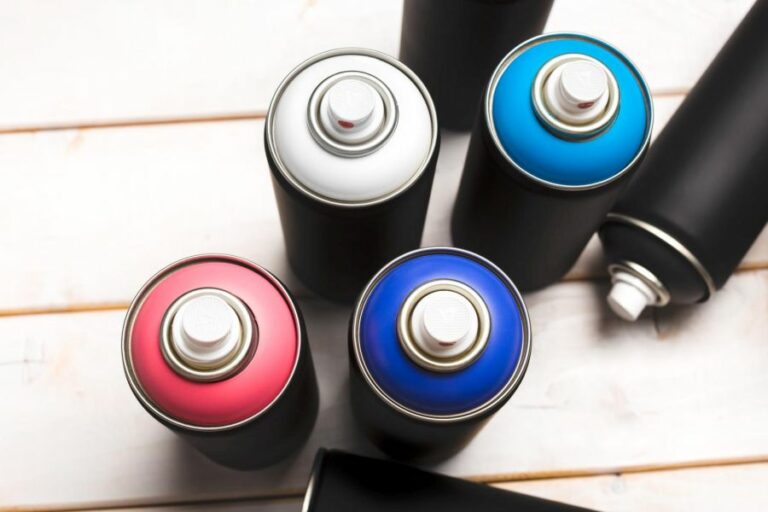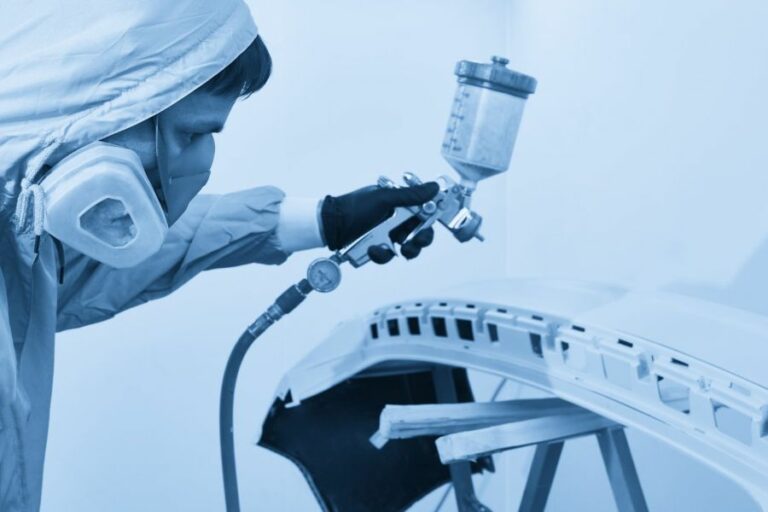How To Paint Outdoor Concrete, 25 Things You Should Know
Are you looking to give your outdoor concrete surfaces a fresh and vibrant look? Well, you’ve come to the right place! With the right approach and materials, painting your outdoor concrete can be a breeze. Follow our step-by-step guide and learn how to easily achieve professional-level results, transforming your space into a beautifully updated and protected area.
How to paint outdoor concrete:
To paint outdoor concrete, select the right paint, such as acrylic-based paint or concrete stain. Clean and prepare the surface by removing dirt, repairing cracks, and etching the concrete. Apply a concrete primer, followed by your chosen paint or stain. Apply two coats for durability and even coverage. Finally, seal the surface with a concrete sealer to protect against moisture and UV damage.

Get ready to transform your ordinary outdoor concrete surface into a visually stunning space. Discover expert tips and techniques for priming, painting, and sealing. Bring out the artist in you and tap into your creativity. Don’t miss out. Read on to unveil the secrets to a beautifully painted outdoor concrete masterpiece!
Contents
- 1 Guide to Painting Exterior Concrete Surfaces
- 2 What Type of Paint Should You Utilize on Exterior Concrete Surfaces?
- 3 Is it Possible to Simply Apply Paint Over Concrete?
- 4 Is Painting Outdoor Concrete a Durable and Long-lasting Solution?
- 5 Is it necessary to apply primer to the concrete before commencing with painting?
Guide to Painting Exterior Concrete Surfaces
Painting outdoor concrete can be a challenging task, but with the right preparation and techniques, you can transform your concrete surfaces into an eye-catching focal point.
• Selecting the Right Type of Paint
The first step in the process is selecting the appropriate type of paint for your outdoor concrete surfaces. When it comes to painting concrete, you have two main options: concrete paint and concrete stain.
– Concrete Paint
Concrete paint creates a solid, opaque layer on the surface, hiding any imperfections or discolorations. A good quality outdoor concrete paint should be acrylic-based, as it provides excellent adhesion, durability, and resistance to weather conditions.
Make sure to choose a paint specifically designed for outdoor use, as these paints will include additional UV protection and be more resistant to moisture and temperature changes.
Recommended brands for outdoor concrete paint include:
- BEHR Premium
- Sherwin-Williams
– Concrete Stain
Concrete stain, on the other hand, penetrates the surface, providing a translucent, semi-transparent finish that highlights the natural texture of the material. Concrete stains are available in both water-based and acid-based formulations.
Water-based stains are easier to apply and clean up, while acid-based stains create more unique, variegated coloring effects.
Some recommended brands offering outdoor concrete stains include:
- Valspar
- Eagle
• Preparing the Surface
Before you begin painting your concrete surfaces, it is crucial to clean and prepare the surface. Proper preparation will ensure that the paint adheres properly and lasts longer.
– Step 1: Remove Dirt, Debris, and Stains
Begin by sweeping the area to remove any loose dirt, leaves, or other debris. Then, use a power washer or a garden hose with a high-pressure nozzle to remove any remaining dirt and grime from the surface.
If you encounter any oil or grease stains, use a concrete degreaser to break down and remove the residue.
– Step 2: Repair Cracks and Chips
Inspect the surface for any cracks, chips, or other damage. Use a concrete repair product, such as hydraulic cement or concrete patch, to fill in any cracks or holes. Make sure to follow the manufacturer’s instructions for proper application and drying times.
– Step 3: Prep the Surface for Painting
To ensure the best adhesion and, most even finish, it is essential to etch or roughen the surface of the concrete before painting. You can achieve this using a commercial etching product or by mechanically grinding or sandblasting the surface.
This step will create a textured surface that will allow the paint to bond more securely with the concrete.
• The Painting Process
Now that your surface is clean and prepared, you can begin the process of painting your outdoor concrete.
– Step 1: Apply a Concrete Primer
Applying a concrete primer is essential, enhancing paint adhesion and ensuring a more even and uniform finish. Use a paint roller or sprayer to apply a concrete primer evenly across the surface. Follow the manufacturer’s instructions regarding drying times and any necessary additional coats.
– Step 2: Apply Concrete Paint or Stain
Once the primer is dry, it’s time to apply your chosen paint or stain. Whether using a paintbrush, roller, or sprayer, make sure to apply the paint evenly and follow the manufacturer’s instructions on coverage, drying times, and re-coating. It is generally best to apply at least two coats to ensure even coverage and a durable finish.
– Step 3: Seal the Surface
After the paint or stain has dried, apply a concrete sealer to protect the surface from moisture, UV rays, and other environmental factors that can cause premature wear and fading. A quality concrete sealer will prolong the life of your painted surface and keep it looking fresh and vibrant for years to come.
• Additional Tips for a Successful Project
- Always check the weather forecast before beginning your project. Painting outdoor concrete should be done in dry conditions with temperatures between 50°F and 90°F. Avoid painting in direct sunlight, as this can cause the paint to dry too quickly and result in an uneven finish.
- Keep in mind that painted concrete surfaces can become slippery when wet. Consider mixing a non-slip additive, such as sand or polymeric beads, into your paint to provide additional slip resistance.
- Always follow the manufacturer’s instructions for each product you use during the painting process, including their recommendations for drying times, coverage, and re-coating.
With the proper planning, preparation, and techniques, you can successfully paint your outdoor concrete surfaces, adding beauty and value to your property. Follow the steps outlined in this guide to ensure a durable, long-lasting, and aesthetically pleasing final result.
Step | Description |
|---|---|
1 | Clean the concrete surface thoroughly by sweeping, scrubbing, and rinsing with water. |
2 | Repair any cracks or holes in the concrete with a patching compound, then allow it to cure according to the manufacturer’s instructions. |
3 | Apply a concrete primer to the surface using a long-handled roller to ensure an even coat. Allow the primer to dry according to the manufacturer’s recommendations. |
4 | Paint the concrete with an outdoor-specific paint, starting at the back and working your way towards an exit. Apply the paint in thin, even coats, and allow it to dry according to the manufacturer’s instructions. |
5 | Apply a second coat of paint, if necessary, allowing it to dry completely before using the concrete surface. |
6 | Consider applying a protective sealer to the painted surface to prolong its life and protect against moisture and abrasion. |
What Type of Paint Should You Utilize on Exterior Concrete Surfaces?
Outdoor concrete surfaces require durable and long-lasting paint that can withstand the elements and foot traffic. Choosing the right paint for your project is essential to ensure your painted surface’s best results and longevity.
• Types of Paint for Outdoor Concrete
There are several types of paint that are suitable for outdoor concrete surfaces. These include:
1. Acrylic Latex Paint
Acrylic latex paint is a popular choice for outdoor concrete because of its durability and resistance to UV rays, mildew, and water. It is also easy to clean and maintain, making it an excellent choice for high-traffic areas.
Acrylic latex paint provides excellent adhesion to concrete surfaces and is available in various colors and finishes, allowing you to achieve the desired look for your outdoor space.
2. Epoxy Paint
Epoxy paint is a two-component paint system that consists of epoxy resin and a hardener.
When mixed and applied according to the manufacturer’s instructions, the epoxy paint forms an extremely durable, chemical-resistant, and long-lasting finish ideal for garage floors, patios, and other heavy-duty outdoor concrete surfaces.
The application process can be a bit more complicated than other paint options, but the resulting finish is resilient and well-suited for high-traffic areas.
3. Concrete Stain
A concrete stain is a water-based product that penetrates the concrete’s surface, creating a semi-transparent, durable, and UV-resistant finish.
While not technically paint, concrete stain is an excellent option for outdoor concrete surfaces, as it allows the natural texture of the concrete to show through while providing a level of protection from the elements.
Concrete stains come in various colors and tints, making them a versatile choice for enhancing the appearance of your outdoor concrete.
• Choosing the Right Paint for Your Project
When selecting the best paint for your outdoor concrete project, consider the following factors:
1. Surface Preparation
Properly preparing the concrete surface is crucial to ensure the longevity and performance of the paint. Begin by cleaning the surface thoroughly, removing any dirt, debris, and stains.
If the concrete is new or has never been painted, you may need to use a concrete etching solution to create a suitable surface for the paint. Examine the surface for any cracks or damage, and fill it with a suitable concrete repair product if necessary.
Not all paints are compatible with surfaces that have been previously painted. If your outdoor concrete has an existing paint finish, you may need to remove it before applying a new coat. Consult the manufacturer’s instructions and follow the recommended preparation techniques for your chosen paint.
2. Application Method
Choose a paint that is easy to apply and well-suited for the specific surface you are working on. Acrylic latex paint and concrete stains can be easily applied with a brush, roller, or sprayer, making them a user-friendly option for those with limited painting experience.
Epoxy paint requires a more complex application process, which may be better suited for those with experience or those willing to invest additional time in getting the job done right.
3. Durability and Maintenance
Consider the level of wear and tear your outdoor concrete surface will experience, and choose a paint that offers the appropriate level of durability. Epoxy paint is the most durable and long-lasting option, while acrylic latex paint and concrete stains offer moderate durability.
Maintenance requirements vary depending on the paint, with acrylic latex paint and concrete stains generally being easier to maintain and touch up than epoxy paint.
• Tips for Applying Paint to Outdoor Concrete
To ensure the best results when painting your outdoor concrete surface, follow these helpful tips:
- Weather Conditions: Paint should be applied in dry, mild weather conditions. Avoid painting during extremely hot, cold, or humid conditions, as this can negatively impact the paint’s adhesion and drying time.
- Proper Ventilation: If you are painting in an enclosed area, such as a garage, ensure proper ventilation to allow the paint to dry fully and limit the risk of inhaling harmful fumes.
- Multiple Coats: Depending on the type of paint and the specific surface, multiple coats may be necessary to achieve an even, durable finish. Follow the manufacturer’s recommendations for proper coverage and recoat times.
- Sealer: Applying a high-quality sealer to your outdoor concrete surface after painting can bridge additional protection, helping to prevent fading, peeling, and damage from water and other elements.
In conclusion, selecting the appropriate paint for your outdoor concrete surface involves careful consideration of the surface’s condition, the desired appearance, and the level of durability and maintenance required.
By following these guidelines and tips, you can ensure a successful painting project that will leave your outdoor concrete looking beautiful and well-protected for years to come.
Type of Paint | Description | Advantages |
|---|---|---|
Masonry Paint | Masonry paint, also known as elastomeric paint, is specifically designed for painting and protecting concrete surfaces. | – Waterproofing properties – Flexibility to withstand temperature changes – Long-lasting color retention |
Epoxy-Based Paint | Epoxy-based paints offer a strong and durable finish that is resistant to chemicals, staining, and abrasion. | – Strong, durable finish – Chemical and stain resistant – Abrasion-resistant |
Acrylic Latex Paint | Acrylic latex paint is a water-based paint that provides excellent coverage and durability for exterior concrete surfaces. | – Water-resistant – Dries quickly – Easy to clean up – Low odor |
Is it Possible to Simply Apply Paint Over Concrete?
• Understanding Concrete Surfaces
Before diving into the process of painting over concrete, it’s essential to understand the nature of concrete surfaces. Concrete is a porous material, meaning it has tiny holes that allow moisture, air, and other elements to penetrate its surface.
This characteristic is vital when deciding how to approach painting over concrete, as these pores can impact the paint’s adherence and overall finished appearance.
In addition to being porous, concrete surfaces can also be subject to various environmental factors, such as moisture, temperature, and structural stress. These factors can impact the durability, appearance, and overall success of your paint job.
With these considerations in mind, it’s vital to ensure that you are using the correct equipment, materials, and methods when painting over concrete surfaces.
• Why Prepare the Surface for Painting?
Preparing the surface adequately before painting is crucial to ensure that the paint adheres properly, provides long-lasting protection, and maintains a visually appealing appearance.
Furthermore, concrete surfaces can be uneven and have fine particles and other contaminants. These imperfections can affect the performance of the paints, leading to peeling, uneven coverage, and poor-quality finishes.
– Cleaning the Surface
The first step in preparing a concrete surface for painting is to clean it thoroughly. This removal of dirt, debris, and contaminants is crucial for ensuring proper paint adhesion and a professional-looking final result.
There are several ways to clean concrete surfaces effectively:
- Pressure washing: This method effectively removes dirt, debris, and contaminants. It’s recommended for exterior concrete surfaces such as driveways, patios, and sidewalks. Pressure washers might not be ideal for interior concrete surfaces as they could create a mess indoors.
- Scrubbing with a detergent: For interior surfaces, a mild detergent, warm water, and a scrub brush work effectively in removing dirt and debris. Rinse the surface with water and let it dry completely before continuing the painting process.
- Using a concrete cleaner: Concrete-specific cleaners, such as Trisodium Phosphate (TSP), can efficiently remove oil and grease stains from the surface. Follow the manufacturer’s instructions for using these products, and always wear gloves and protective eyewear.
– Repairing Damaged Concrete
After cleaning the surface, inspect it for any damage or imperfections. Concrete surfaces can have cracks or holes that must be addressed before painting. Fixing these issues will give you a better end result and ensure the longevity of your paint job.
- Cracks: Use a concrete crack filler or sealant to repair any cracks in the concrete. Follow the product instructions to apply and allow it to cure thoroughly before painting.
- Holes: Use a concrete patching compound to fill any holes on the surface. Follow the product instructions to apply and allow it to cure completely before painting.
• Selecting the Right Paint and Primer
Not all paint is suitable for concrete surfaces. As concrete is porous and alkaline, using the wrong type of paint might lead to undesirable outcomes, such as peeling, bubbling or premature failure of the paint job.
– Primer
Using a concrete primer is crucial to ensure proper paint adhesion and improve the final appearance. A primer designed for use on concrete surfaces will penetrate the pores and provide a strong foundation for the paint to adhere.
There are two types of primers designed for concrete:
- Concrete bonding primers: These primers ensure a strong bond between the paint and the concrete surface. Look for water-based acrylic formulas that can withstand moisture and resist peeling.
- Masonry primers: These primers are specifically formulated for porous surfaces, such as concrete or brick. They seal the surface and provide an excellent base for paint application.
Choose a primer that is compatible with the type of paint you plan to use for the topcoat.
– Paint
For concrete surfaces, consider using paint specifically formulated for concrete or masonry. These paints are designed to penetrate and adhere to the surface, resist moisture, and withstand the stresses common to concrete structures.
There are two common types of paint suitable for concrete surfaces:
- Acrylic latex paint: This type of paint provides a durable, long-lasting finish, adheres well to the surface, and is resistant to peeling and chipping.
- Elastomeric paint: This paint is designed specifically for masonry surfaces, such as concrete. It is more flexible than standard paint, allowing it to expand and contract with the concrete without cracking or flaking.
Be sure to follow the manufacturer’s instructions and recommendations for surface preparation, application, and drying times for the paint you choose.
• Painting Over Concrete: Step by Step
- Preparation: Ensure the surface is clean and free of imperfections. Apply primer to the entire area, following the product instructions for drying times.
- Paint application: Use a high-quality paintbrush or roller designed for use with the paint type you’ve chosen. Apply an even coat, ensuring proper coverage of the entire area. Be mindful of any drips or pooling.
- Drying and recoating: Allow the paint to dry according to the manufacturer’s instructions before applying additional coats to achieve better coverage, if necessary.
- Finishing touches: After the paint has dried completely, inspect the surface for any touch-ups or areas that may need additional attention.
• Conclusion
While painting over concrete can be done successfully, it requires adequate surface preparation, using the right primer and paint, and following a proper painting technique.
With the proper approach and attention to detail, you can achieve a professional, durable, and attractive result for your concrete surfaces.
Factors | Description |
|---|---|
Surface Preparation | The concrete surface must be clean and free of dirt, grease, and other contaminants before painting. |
Moisture Content | Ensure the concrete is fully cured and dry to avoid trapping moisture that can cause paint peeling or blistering. |
Concrete Porosity | Seal porous concrete and allow sealer to cure before painting to ensure proper paint adhesion. |
Paint Type | Choose a high-quality paint specifically designed for concrete surfaces for the best results and durability. |
Priming | Apply a concrete primer before painting to enhance paint adhesion and improve the overall finish. |
Is Painting Outdoor Concrete a Durable and Long-lasting Solution?
Outdoor concrete surfaces can benefit from a fresh coat of paint, whether for aesthetic reasons or to improve durability. However, you may be wondering if painting outdoor concrete actually lasts in the long run.
• Longevity of Painted Outdoor Concrete
The short answer to whether painted outdoor concrete lasts is – yes, it can. However, various factors determine the longevity of painted outdoor concrete, including the choice of paint, surface preparation, environmental conditions, and maintenance.
When properly executed, painted outdoor concrete surfaces can last for several years, and in some cases, even up to a decade. Choosing the correct paint and following the recommended application process is crucial for prolonging the lifespan of painted outdoor concrete.
• Choosing the Right Paint
The first and foremost factor that determines the longevity of an outdoor painted concrete surface is the quality and type of paint you use. It is essential to select a paint that is specifically designed for concrete surfaces and intended for outdoor use.
These paints are formulated to withstand weather elements, resist fading and peeling, and provide long-lasting protection to the concrete surface.
Some top-performing paints for outdoor concrete surfaces include:
- 100% Acrylic Latex Paint: These types of paint are water-based and provide excellent adhesion, durability, and resistance to cracking, fading, and peeling. The American Concrete Institute recommends using 100% acrylic latex paint for outdoor concrete surfaces.
- Epoxy Paint: Epoxy paint is a resin-based paint that is highly resistant to chemicals, moisture, and abrasion. This paint can be an excellent choice for outdoor concrete surfaces, especially when it is mixed with a suitable curing agent.
- Elastomeric Paint: This type of paint is specially formulated to resist cracking and accommodate surface movements, making it suitable for outdoor concrete surfaces exposed to extreme weather conditions.
• Proper Surface Preparation
Proper surface preparation is critical for achieving long-lasting painted outdoor concrete. Failing to prepare the concrete surface correctly may result in poor adhesion, peeling, cracking, and a reduced lifespan of the paint job.
Here are some essential steps for preparing an outdoor concrete surface for painting:
- Clean the surface: Remove dirt, debris, and any loose or flaking paint using a stiff brush, pressure washer, or paint stripper. Be sure to address any mold or mildew using a commercial mildew remover or a solution of bleach and water.
- Repair any cracks or damages: Inspect the surface for any cracks or damages and use a suitable patching or filling compound to make the necessary repairs, following the manufacturer’s instructions. Allow the surface to dry and cure completely.
- Apply a concrete primer: Applying a concrete primer can provide an excellent foundation for the paint, enhancing adhesion and durability. Choose a primer that is compatible with your chosen paint and follow the manufacturer’s guidelines for application.
• Environmental Conditions and Maintenance
The longevity of painted outdoor concrete can also depend significantly on the environmental conditions the surface is exposed to and the level of maintenance you perform. Extreme weather, temperature fluctuations, and exposure to moisture can all affect the lifespan of painted concrete.
To protect your painted outdoor concrete surface, follow these tips:
- Apply a sealer: Applying a concrete sealer over the paint can add an additional layer of protection and help prolong the life of the paint job. Choose a sealer that is compatible with your paint and follow the manufacturer’s instructions for application.
- Regularly clean the surface: Keep your painted concrete surface clean of dirt, debris, and stains by regularly sweeping or washing it with mild detergent and water.
- Perform periodic inspections: Inspect the surface regularly to identify any signs of wear or damage, such as peeling or cracking paint, and address them promptly.
- Repaint as needed: Even the best-painted outdoor concrete surfaces may require repainting after several years. Be prepared to repaint your outdoor concrete surface when signs of wear or fading become evident.
By following these guidelines and best practices, you can maximize the lifespan of your painted outdoor concrete surface, ensuring that it looks attractive and well-maintained for years to come.
Is it necessary to apply primer to the concrete before commencing with painting?
• Importance of Priming Concrete
Initiating a concrete painting project typically involves quite a bit of preparation to ensure that the final result is a long-lasting and untarnished finish. An essential step in this preparation process is to prime the concrete before applying paint. Priming concrete has several benefits, such as:
- Enhancing paint adhesion: Priming the surface helps the paint bond better with the concrete, reducing the likelihood of peeling or flaking.
- Sealing the surface: A coat of primer helps to seal pores in the concrete, preventing the paint from penetrating too deeply and becoming uneven.
- Reducing paint absorption: The primer acts as a barrier, preventing excessive absorption of paint by the concrete. This results in a more even, consistent finish and saves on paint costs.
- Preventing discoloration: Priming helps to prevent any stains or discoloration in the concrete from showing through the paint. Additionally, it can prevent chemical reactions between the concrete and paint, which could lead to unsightly blotches.
Given these advantages, it is clear that priming concrete before paint application is a crucial step to achieving a pristine and long-lasting finish.
• Choosing the Right Primer
To attain optimal results, selecting the appropriate primer for your concrete surface is essential. A common choice for concrete is a masonry primer, specially formulated to provide excellent adhesion and seal the surface effectively.
These primers typically offer water resistance and protection against alkalinity present in the concrete.
Acrylic-based primers are another suitable option for concrete, particularly those designed for masonry surfaces. These water-based products provide excellent adhesion, dry quickly, and are easy to clean up.
It is crucial to read the product label carefully and choose a primer specifically designed for use on concrete surfaces.
• Preparing the Concrete Surface
Before applying the primer, it is vital to prepare the concrete surface properly. Neglecting this step can lead to inadequate adhesion and an unsatisfactory result. Key steps in the preparation process include:
– Cleaning the Surface
Remove any dirt, debris, grease, or oil from the concrete surface using a wire brush, stiff-bristled broom, or power washer. If stains persist, consider using a specialized concrete cleaner or degreaser to dissolve them. Ensure that the surface is completely clean and dry before moving on to the next step.
– Repairing Cracks and Holes
Inspect the concrete for any cracks or holes that require repair. Use a concrete filler or patching compound to fill these imperfections, applying it according to the manufacturer’s instructions. Allow the repair material to dry and cure fully before sanding the surface to create a smooth, even finish.
– Testing for Moisture and Alkalinity
Conduct a moisture and alkalinity test on the concrete surface before applying primer. High moisture content or alkalinity can negatively affect the primer’s adhesion and cause the paint to peel or flake. To address these issues, use specialized products that combat excessive moisture or alkaline conditions.
• Priming the Concrete
After preparing the surface, you can begin the priming process. Follow these steps to achieve a successful result:
- Stir the primer: Mix the primer thoroughly, ensuring that no sediment remains at the bottom of the container.
- Apply the primer: Using a roller, brush, or sprayer, apply a thin, even layer of primer to the surface. Ensure that you cover the entire area to create a uniform barrier.
- Allow the primer to dry: Refer to the product label for drying times, which typically range from two to six hours. It is important not to rush this step, as applying paint over a wet primer can lead to adhesion issues and an uneven finish.
- Inspect the surface: After the primer has dried, check the surface for any missed spots or uneven application. Apply additional primer if necessary to achieve a consistent and flawless base for your paint.
• Conclusion
Priming concrete before painting is an essential process that significantly enhances the durability and aesthetics of your finished project.
By choosing the appropriate primer, preparing the surface correctly, and following proper application techniques, you can achieve a professional-looking result that stands the test of time.







